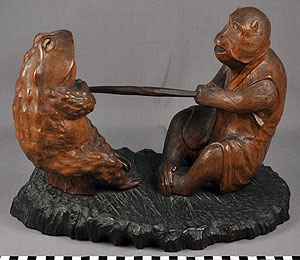| Description |
This is a Japanese boxwood okimono of a monkey (saru) playing tug of war (kubihiki) with a bullfrog (kaeru). This game of strength is typically played at a time of a full moon in recognition of its invisible gravitational pull, and it is said that the contest determines who will have good fortune in the coming year. By depicting a monkey and a frog in competition, the artist may be referencing the Rice Cake Race, a tale where the two animals chased a rice mortar down a mountain to determine which would win the rice cake inside. The cake fell out of the mortar and was only noticed by the frog, making the monkey the loser of the contest despite its quicker nature.
The okimono, meaning “object of display,” is a Japanese model or free-standing figure that developed from the smaller netsukes, which were clothing fasteners that appeared as three-dimensional carved figures or flattened and engraved buttons or boxes. As okimono were ornamental pieces, they were frequent exports for western markets. They took on various sizes and were typically carved from wood or ivory.
Common muses for okimonos, particularly for western audiences, included entertainers, Samurai heroes, bijin (beautiful ladies), animals, mythological figures of legend and folklore, and any other figure that embodied traditional Japanese life.
Japanese art exports helped to finance the cost of modernization programs implemented by the Meiji government. Osaka was the center of commerce of the Edo period due to its remoteness from the Tokugawa shogunate. As artistic expression had stagnated in Japan due to government controls over art forms, the merchant class of this city was eager for the dramatic joruji and kabuki theater styles. These performances also spread to Edo (now Tokyo) after it was rebuilt following a fire in 1657, particularly in the entertainment and brothel district (Yoshiwara). The proliferation of the theater arts popularized performer dress like kimonos and, as a result, contributed to the development of clothing items like the inro and netsuke.
After the establishment of the Meiji government (1868) and the abolition of the samurai class (1876), artisans lost their traditional patrons and sought out new work for their skill sets. This was also the time when art and industry exhibitions were popularized, and the commercial success of Japanese art convinced the government to establish enterprises that commissioned professional artists. One of the prestigious occupations that was established by this trend was the Teishitsu Gigei'in (Imperial Court Artist) who, in name, worked under the patronage of the imperial family. It was through these efforts that Japanese art gained world popularity. |
| Bibliography |
Spurlock Museum of World Cultures. Sculpted Stories: Selected Works from the Fred Freund Collection. University of Illinois at Urbana-Champaign, 2020.
Bordignon, Laura. The Golden Age of Japanese Okimono: Dr. A.M. Kanter’s Collection = 黄金時代の日本の置物美術: A.m. カンター医学博士コレクション. Woodbridge: Antique Collectors’ Club, 2010.
Guth, Christine. Art of Edo Japan: The Artist and the City, 1615-1868. New York: Harry N. Abrams, Inc., 1996.
Impey, Oliver, and Malcolm Fairley. The dragon king of the sea: Japanese decorative art of the Meiji period from the John R. Young collection. Oxford: Ashmolean Museum, 1991.
Irvine, Gregory, Axel Rüger, Hiroko Yokomizo, Tayfun Belgin, John House, and Kris Schiermeier. Japonisme and the Rise of the Modern Art Movement: The Arts of the Meiji Period: The Khalili Collection. London: Thames & Hudson, 2013.
Jahss, Melvin, and Betty Jahss. Inro and other miniature forms of Japanese Lacquer Art. Tokyo: Tuttle Publishing, 1971.
Okada, Barbra Teri. A Sprinkling of Gold: The Lacquer Box Collection of Elaine Ehrenkranz. Newark: The Newark Museum, 1983.
Okada, Barbra Teri., and Mary Gardner Neill. Real and Imaginary Beings: The Netsuke Collection of Joseph and Edith Kurstin. Yale University Art Gallery, 1980.
Vos, F., Jan Dees, Frits Scholten, Oliver Impey, Malcolm Fairley, E.A. Wrangham, and Roger Keyes. Meiji, Japanese art in transition: ceramics, cloisonné, lacquer, prints, illustrated books, drawings and paintings from the Meiji period (1868-1912). Edited by Robert Schaap. ’s-Gravenhage: Haags Gemeentemuseum, 1987. |
